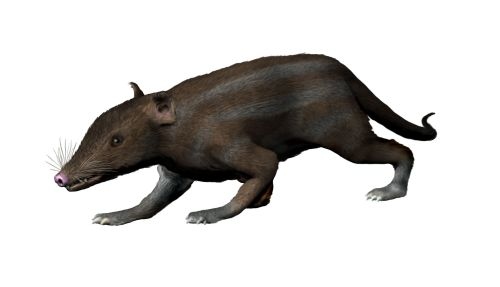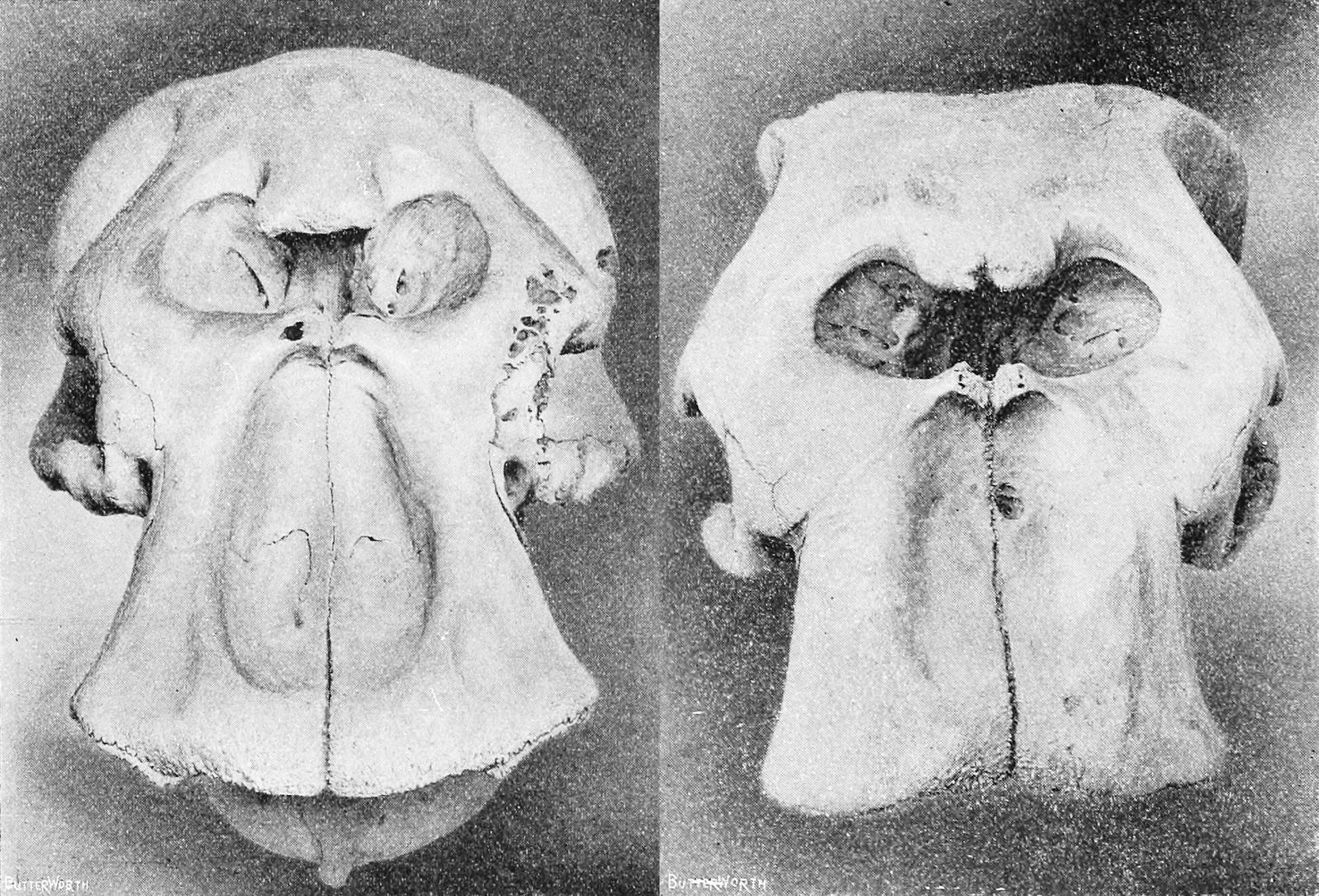|
Theria
Theria ( or ; ) is a scientific classification, subclass of mammals amongst the Theriiformes. Theria includes the eutherians (including the Placentalia, placental mammals) and the metatherians (including the marsupials) but excludes the egg-laying monotremes and various extinct mammals evolving prior to the common ancestor of placentals and marsupials. Characteristics Therians give birth to live young without a shelled egg (biology), egg. This is possible thanks to key proteins called Syncytin-1, syncytins which allow exchanges between the mother and its offspring through a placenta, even Marsupial#Reproductive system, rudimental ones such as in marsupials. Genetic studies have suggested a viral origin of syncytins through the Endogenous retrovirus, endogenization process. The marsupials and the placentals evolved from a common therian ancestor that gave live birth by suppressing the mother's immune system. While the marsupials continued to give birth to an underdeveloped fe ... [...More Info...] [...Related Items...] OR: [Wikipedia] [Google] [Baidu] |
Eutheria
Eutheria (from Greek , 'good, right' and , 'beast'; ), also called Pan-Placentalia, is the clade consisting of Placentalia, placental mammals and all therian mammals that are more closely related to placentals than to marsupials. Eutherians are distinguished from non-eutherians by various phenotypic traits of the feet, ankles, jaws and teeth. All extant eutherians lack epipubic bones, which are present in all other living mammals (marsupials and monotremes). This allows for expansion of the abdomen during pregnancy, though epipubic bones are present in many primitive eutherians. Eutheria was named in 1872 by Theodore Gill; in 1880, Thomas Henry Huxley defined it to encompass a more broadly defined group than Placentalia. The earliest unambiguous eutherians are known from the Early Cretaceous Yixian Formation of China, dating around 120 million years ago. Two tribosphenic mammals, ''Durlstodon'' and ''Durlstotherium'' from the Berriasian age (~145–140 million years ago) of t ... [...More Info...] [...Related Items...] OR: [Wikipedia] [Google] [Baidu] |
Metatheria
Metatheria is a mammalian clade that includes all mammals more closely related to marsupials than to placentals. First proposed by Thomas Henry Huxley in 1880, it is a more inclusive group than the marsupials; it contains all marsupials as well as many extinct non-marsupial relatives. It is one of two groups placed in the clade Theria alongside Eutheria, which contains the placentals. Remains of metatherians have been found on all of Earth’s continents. Description Distinctive characteristics ( synapomorphies) of Metatheria include a prehensile tail, the development of a capitular tail on the humerus, the loss of tooth replacement on the second and fifth premolars, lower canines that outwardly diverge from each other, an angular process on the dentary bone—which additionally bears a posterior shelf in its masseteric fossa in Metatheria—that is equal to or greater than the length of the ramus, and the lower fifth premolar with a "very trenchant" cristid obliqua/ecto ... [...More Info...] [...Related Items...] OR: [Wikipedia] [Google] [Baidu] |
Mammal
A mammal () is a vertebrate animal of the Class (biology), class Mammalia (). Mammals are characterised by the presence of milk-producing mammary glands for feeding their young, a broad neocortex region of the brain, fur or hair, and three Evolution of mammalian auditory ossicles, middle ear bones. These characteristics distinguish them from reptiles and birds, from which their ancestors Genetic divergence, diverged in the Carboniferous Period over 300 million years ago. Around 6,640 Neontology#Extant taxon, extant species of mammals have been described and divided into 27 Order (biology), orders. The study of mammals is called mammalogy. The largest orders of mammals, by number of species, are the rodents, bats, and eulipotyphlans (including hedgehogs, Mole (animal), moles and shrews). The next three are the primates (including humans, monkeys and lemurs), the Artiodactyl, even-toed ungulates (including pigs, camels, and whales), and the Carnivora (including Felidae, ... [...More Info...] [...Related Items...] OR: [Wikipedia] [Google] [Baidu] |
Marsupialia
Marsupials are a diverse group of mammals belonging to the infraclass Marsupialia. They are natively found in Australasia, Wallacea, and the Americas. One of marsupials' unique features is their reproductive strategy: the young are born in a relatively undeveloped state and then nurtured within a pouch on their mother's abdomen. Extant marsupials encompass many species, including kangaroos, koalas, opossums, possums, Tasmanian devils, wombats, wallabies, and bandicoots. Marsupials constitute a clade stemming from the last common ancestor of extant Metatheria, which encompasses all mammals more closely related to marsupials than to placentals. The evolutionary split between placentals and marsupials occurred 125-160 million years ago, in the Middle Jurassic-Early Cretaceous period. Presently, close to 70% of the 334 extant marsupial species are concentrated on the Australian continent, including mainland Australia, Tasmania, New Guinea, and nearby islands. The remain ... [...More Info...] [...Related Items...] OR: [Wikipedia] [Google] [Baidu] |
Placentalia
Placental mammals ( infraclass Placentalia ) are one of the three extant subdivisions of the class Mammalia, the other two being Monotremata and Marsupialia. Placentalia contains the vast majority of extant mammals, which are partly distinguished from monotremes and marsupials in that the fetus is carried in the uterus of its mother to a relatively late stage of development. The name is something of a misnomer, considering that marsupials also nourish their fetuses via a placenta, though for a relatively briefer period, giving birth to less-developed young, which are then nurtured for a period inside the mother's pouch. Placentalia represents the only living group within Eutheria, which contains all mammals that are more closely related to placentals than they are to marsupials. Anatomical features Placental mammals are anatomically distinguished from other mammals by: * a sufficiently wide opening at the bottom of the pelvis to allow the birth of a large baby relative to ... [...More Info...] [...Related Items...] OR: [Wikipedia] [Google] [Baidu] |
Juramaia
''Juramaia'' is an extinct genus of a therian mammal, possibly a very basal eutherian mammal, known from the Late Jurassic ( Oxfordian stage) or Early Cretaceous deposits of western Liaoning, China. It is a small shrew-like mammal weighing around . Discovery ''Juramaia'' is known from the holotype BMNH PM1343, an articulated and nearly complete skeleton including incomplete skull preserved with full dentition. It was collected in the Daxigou site, Jianchang, from the Tiaojishan Formation dated at about . It was first named by Zhe-Xi Luo, Chong-Xi Yuan, Qing-Jin Meng and Qiang Ji in 2011 and the type species is ''Juramaia sinensis''. Classification The discovery of ''Juramaia'' provides new insight into the evolution of placental mammals by showing that their lineage diverged from that of the marsupials 35 million years earlier than previously thought. Furthermore, its discovery fills gaps in the fossil record and helps to calibrate modern, DNA-based methods of dating the ... [...More Info...] [...Related Items...] OR: [Wikipedia] [Google] [Baidu] |
Theriiformes
Theriiformes is a clade of mammals. The term was coined by Timothy B. Rowe in his doctoral dissertation, and is defined as the clade formed by the most recent common ancestor of multituberculates (which form part of the broader group Allotheria, along with Gondwanatheria and likely all/part of Haramiyida) and Theria (the group containing marsupials and placental mammals). Mammals more closely related to therians than to multituberculates are included in the clade Trechnotheria. As multituberculates are usually considered more closely related to therians than monotremes are (though some studies have recovered allotherians as less closely related to therians than monotremes are, placing them outside of crown group Mammalia) it is considered to be a subgroup of the mammalian crown group In phylogenetics, the crown group or crown assemblage is a collection of species composed of the living representatives of the collection, the most recent common ancestor of the collection, ... [...More Info...] [...Related Items...] OR: [Wikipedia] [Google] [Baidu] |
Patagomaia
''Patagomaia'' is an extinct mammal of uncertain affinities, originally described as a therian mammal, from the Maastrichtian Chorrillo Formation of Argentina. It is the largest Mesozoic mammal yet known, with weight estimates of around . The type species is ''P. chainko''. Description ''Patagomaia chainko'' is known from the distal end of the left ulna, two fragments of the preacetabular wing of the left ilium, acetabular region of the left hemipelvis, fragment of the ischial blade, proximal end of the right femur; distal end of the left femur, proximal end of the left tibia, and other indeterminate bone fragments. It is estimated to weigh over , narrowly beating the previous Mesozoic mammal contender, '' Repenomamus giganticus''. Classification ''Patagomaia chainko'' is tentatively described as a therian mammal. However, it does not match any early Cenozoic South American therian group. Püschel ''et al.'' (2024) subsequently argued that ''Patagomaia'' might be a large gondw ... [...More Info...] [...Related Items...] OR: [Wikipedia] [Google] [Baidu] |
Aardvark
Aardvarks ( ; ''Orycteropus afer'') are medium-sized, burrowing, nocturnal mammals native to Africa. Aardvarks are the only living species of the family Orycteropodidae and the order Tubulidentata. They have a long proboscis, similar to a pig's snout, which is used to sniff out food. They are afrotheres, a clade that also includes elephants, manatees, and hyraxes. They are found over much of the southern two-thirds of the African continent, avoiding areas that are mainly rocky. Nocturnal feeders, aardvarks subsist on ants and termites by using their sharp claws and powerful legs to dig the insects out of their hills. Aardvarks also dig to create burrows in which to live and rear their young. Name and taxonomy Name The aardvark is sometimes colloquially called the "African ant bear", "anteater" (not to be confused with the South American anteaters), or the "Cape anteater" after the Cape of Good Hope. The name "aardvark" is Afrikaans () and comes from earlier Afrikaa ... [...More Info...] [...Related Items...] OR: [Wikipedia] [Google] [Baidu] |
African Elephant
African elephants are members of the genus ''Loxodonta'' comprising two living elephant species, the African bush elephant (''L. africana'') and the smaller African forest elephant (''L. cyclotis''). Both are social herbivores with grey skin. However, they differ in the size and colour of their tusks as well as the shape and size of their ears and skulls. Both species are at a pertinent risk of extinction according to the IUCN Red List; as of 2021, the bush elephant is considered endangered while the forest elephant is considered critically endangered. They are threatened by habitat loss and fragmentation, along with poaching for the illegal ivory trade in several range countries. ''Loxodonta'' is one of two extant genera in the family Elephantidae. The name refers to the lozenge-shaped enamel of their molar teeth. Fossil remains of ''Loxodonta'' species have been found in Africa, spanning from the Late Miocene (from around 7–6 million years ago) onwards. Etymology T ... [...More Info...] [...Related Items...] OR: [Wikipedia] [Google] [Baidu] |




